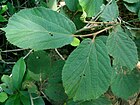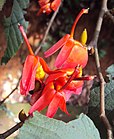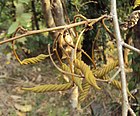Note: This is a project under development. The articles on this wiki are just being initiated and broadly incomplete. You can Help creating new pages.
Helicteres isora - Avartani
Avartani is a shrub or small tree that can reach a height of up to 8 metres, but is more likely to be 4 metres or less in height. Gathered from the wild and used locally as a medicine, the plant has also been experimentally cultivated as a fibre plant in India.
Contents
- 1 Uses
- 2 Parts Used
- 3 Chemical Composition
- 4 Common names
- 5 Properties
- 6 Habit
- 7 Identification
- 8 List of Ayurvedic medicine in which the herb is used
- 9 Where to get the saplings
- 10 Mode of Propagation
- 11 How to plant/cultivate
- 12 Commonly seen growing in areas
- 13 Photo Gallery
- 14 References
- 15 External Links
Uses
Diarrhea, Dysentery, Intestinal parasites [1]
Parts Used
Chemical Composition
Common names
| Language | Common name |
|---|---|
| Kannada | aavarthini, edamuri, bhootakaralu, yedamuri |
| Hindi | marodphali, marorphali |
| Malayalam | ishvaramuli, itampirivalampiri, valampiri |
| Tamil | edampuri, pirimurukku, valampurikai |
| Telugu | aadasamanthi, adivichamanthi, peddasamanthi, shyaamali |
| Marathi | NA |
| Gujarathi | NA |
| Punjabi | NA |
| Kashmiri | NA |
| Sanskrit | avartani, mrgasrngi, |
| English | Indian screw tree |
Properties
Reference: Dravya - Substance, Rasa - Taste, Guna - Qualities, Veerya - Potency, Vipaka - Post-digesion effect, Karma - Pharmacological activity, Prabhava - Therepeutics.
Dravya
Rasa
Kashaya (Astringent)
Guna
Laghu (Light), Rooksha (Dry)
Veerya
Sheeta (cold)
Vipaka
Karma
Pitta, Kapha
Prabhava
Habit
Identification
Leaf
| Kind | Shape | Feature |
|---|---|---|
| Simple | alternate | 5-12 x 3-8 cm, obovate to suborbicular, apex acute or acuminate, base cordate, margin irregularly crenate- serrate; 3-5-nerved at the base, scabrous above and stellately tomentose below; petioles to 1.2 cm long. |
Flower
| Type | Size | Color and composition | Stamen | More information |
|---|---|---|---|---|
| Bisexual | axillary, solitary or in few-flowered cymes | Red | 10 | bracts 2-3 mm long, linear, 2 brown glands present in the axil of bracts; pedicel to 6 mm long. Calyx slightly yellow, persistent, tubular, splitting in to 5 irregular lobes; tube 1.5-2 cm long , densely stellate hairy without. Petals 5, unequal, 2-2.5 cm long, obovate, clawed, crimson, fading to pale blue. Staminal column 3-3.5 cm long, cylindric; stamens 10 ; staminodes 5. Ovary 2-2.5 mm long, placed at tip of gynophore, 5-lobed, 5-celled; ovules many; style 5; stigma subulate. |
Fruit
| Type | Size | Mass | Appearance | Seeds | More information |
|---|---|---|---|---|---|
| Follicles | 4-6 cm long | spirally twisted, stellate-tomentose, beaked | seeds 2-3 mm long, angular, black, wrinkled. | {{{6}}} |
Other features
List of Ayurvedic medicine in which the herb is used
Where to get the saplings
Mode of Propagation
How to plant/cultivate
H. isora is easily propagated by seed, but vegetative propagation with stem cuttings is also possible. Seeds may be sown in a nursery and the seedlings planted out into the field later. Close planting, with e.g. distances of 60-90 cm, results in long, straight stems, whereas wider planting leads to profuse branching and thus lower fibre quality. [4]
Commonly seen growing in areas
Photo Gallery
References
- ↑ "Uses"
- ↑ "Vernacular names"
- ↑ "BOTANIC DESCRIPTION"
- ↑ Cite error: Invalid
<ref>tag; no text was provided for refs namedCultivation details
External Links
- Pages with reference errors
- Ayurvedic Herbs known to be helpful to treat Diarrhea
- Ayurvedic Herbs known to be helpful to treat Dysentery
- Ayurvedic Herbs known to be helpful to treat Intestinal parasites
- Herbs with Bark used in medicine
- Herbs with Root used in medicine
- Herbs with Fruit used in medicine
- Herbs with common name in Kannada
- Herbs with common name in Hindi
- Herbs with common name in Malayalam
- Herbs with common name in Tamil
- Herbs with common name in Telugu
- Herbs with common name in Sanskrit
- Herbs with common name in English
- Habit - Shrub or small tree
- Index of Plants which can be propagated by Seeds
- Index of Plants which can be propagated by Cuttings
- Herbs that are commonly seen in the region of Tropical area
- Herbs
- Shrub
- Ayurvedic herbs that don't have seed photos
- Malvaceae





